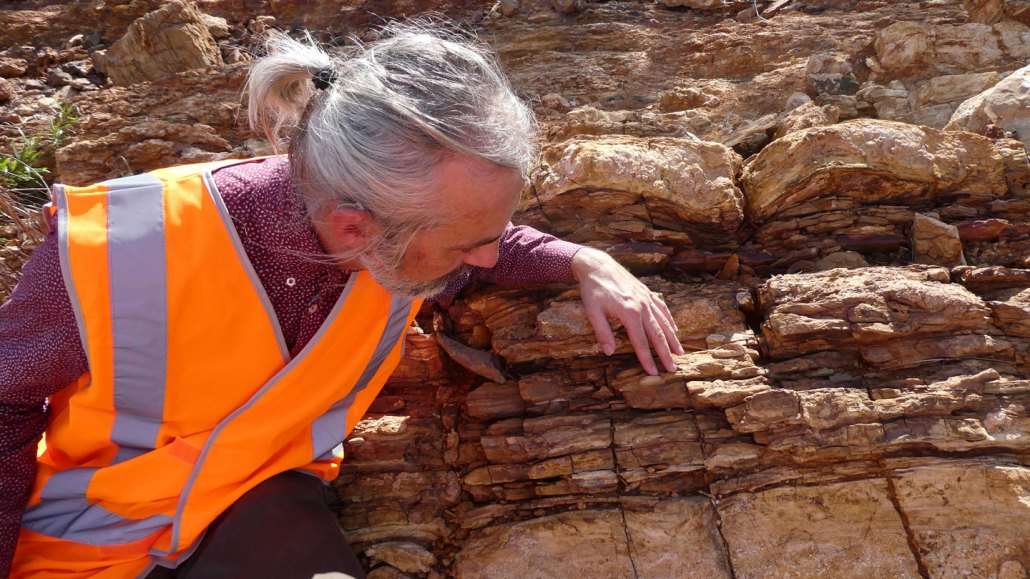
Geochemist Jochen Brocks and colleagues report they discovered the earliest molecular footprints of eukaryotes, dating back 1.6 billion years, in this Barney Creek rock formation in northern Australia.
The Australian National University
Molecular fossils found in ancient sedimentary rocks have unveiled a lost world of primitive eukaryotes that dominated aquatic ecosystems from at least 1.6 billion to 800 million years ago.
The findings, published June 7 in Nature, come from laboratory analyses of rock samples from around the world that revealed remnants of primitive compounds called protosteroids. The majority of these molecules, which form in the process of creating steroids, were likely produced by primordial eukaryotes, relatively complex life-forms that today include animals, plants, algae and fungi, the researchers say.
Almost all eukaryotes produce molecules called steroids, like cholesterol, that are crucial components of cell membranes. Steroids don’t degrade easily and their remnants can be detected in sedimentary rocks as molecular fossils.
The last common ancestor of all eukaryotes lived around 1.2 billion to more than 1.8 billion years ago. But scientists know almost nothing about the abundance, ecology and habitats of those early microorganisms. Molecular and physical fossils of eukaryotes dated to 800 million years ago have been found. But farther back in time, their physical fossils become scarce and molecular fossils of the steroids become undetectable. The existence of protosteroids had been predicted but it was unclear what they would look like — or if they could even be detected — until the researchers figured out a way to re-create those molecular footprints in the lab.
“This study explains why we don’t see footprints of these guys in the rocks, as researchers were looking for the wrong thing,” says biologist Laura Katz, a biologist at Smith College in Northampton, Mass., who was not involved with the new work. “It fills a void in the fossil records.”
A dearth of obvious eukaryote fossils before 800 million years ago led scientists to speculate that the ecosystem at that time was dominated by bacteria. Alternatively, primordial eukaryotes may have simply lacked strength in numbers to leave behind detectable steroid remnants.
Some scientists had a different explanation: What if some intermediate molecule in the chemical pathway that produces modern steroids was actually the end product of the process in primordial eukaryotes? This theory had been proposed by the biochemist Konrad Bloch, who won the Nobel Prize in physiology or medicine in 1964 for discovering the biosynthetic pathway of cholesterol.
To test this, geochemist Jochen Brocks of the Australian National University in Canberra and colleagues artificially matured molecules made in the first few steps of steroid biosynthesis, including lanosterol and cycloartenol. That revealed what the compounds’ molecular fossils would look like. Then the researchers looked for these fossils in tarlike bitumens and oils extracted from ancient rocks from all over the world.
The researchers discovered a deluge of the protosteroids in samples ranging from deep to relatively shallow water environments. The oldest sample, dating back to 1.6 billion years ago, came from the Barney Creek Formation in Australia.
“One of the greatest puzzles of early evolution is, why didn’t our highly capable eukaryotic ancestors come to dominate the world’s ancient waterways? Where were they hiding?” says Benjamin Nettersheim, a geobiologist at University of Bremen in Germany. “We show that the protosteroid-producing microorganisms were hiding in plain sight and were in fact abundant in the world’s ancient oceans and lakes all along.”
While most bacteria produce a different molecule, called hopanoids, some bacteria also have the chemical tools to kick-start protosteroid production. But these bacteria exist in niche environments, such as methane seeps and hydrothermal vents. And their molecular footprints have not been found in sediments older than 800 million years, leading the researchers to conclude that eukaryotes dominated the ancient ecosystems.
“Konrad Bloch would have been delighted, had he lived, to see this,” says MIT geobiologist Roger Summons, who wasn’t involved in the study. “This paper has elegantly confirmed his prediction that biosynthetic precursors to cholesterol reflect ancient life’s quest for improvement.” (Bloch died in 2000.)
Making these steroid precursors requires less oxygen and energy, so that may have given the primordial eukaryotes an advantage in thriving in early Earth’s harsh low oxygen conditions, the researchers propose (SN: 10/30/15).
“If true, [this study] suggests that we may be able to examine the stepwise evolution of eukaryotes at [an] unprecedented level of detail,” says evolutionary biologist Yosuke Hoshino of the GFZ German Research Centre for Geosciences in Potsdam, who was not involved in the study. “This is such a great opportunity to understand the evolution of complex life, which biologists have always dreamed of.”






